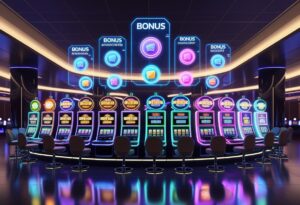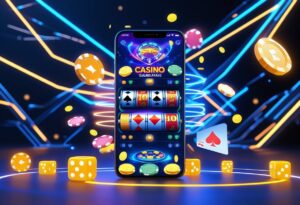Exploring the Role of Gamification in Building Long-Term Player Loyalty
You’ll discover why players become loyal fans through gamification’s psychological triggers and reward systems that keep them coming back.

How Does Gamification Drive Long-Term Player Loyalty?
Key Takeaways
- Psychological reward systems create sustained player engagement
- Social recognition and achievement mechanics foster community connection
- Strategic progression systems build lasting player investment
- Data-driven feedback loops optimize player retention
Understanding Core Gamification Mechanics
Gamification drives player loyalty by combining psychological reward systems with social recognition mechanics to create compelling engagement loops. These mechanics tap into fundamental human motivations:
- Achievement progression
- Social connection
- Skill mastery
- Status recognition
- Personal growth
Implementing Effective Reward Systems
Successful gamification relies on carefully structured reward schedules:
- Variable ratio rewards
- Milestone achievements
- Progression markers
- Social validation
- Exclusive content unlocks
Building Community Through Social Elements
Strong player communities develop through:
- Collaborative challenges
- Team-based activities
- Peer recognition systems
- Social sharing mechanics
- Community milestones
Optimizing Player Progress Systems
Strategic progression design includes:
- Clear advancement paths
- Achievable short-term goals
- Long-term aspirations
- Skill-based challenges
- Performance feedback
Measuring and Improving Retention
Track key metrics to optimize player engagement:
- Daily active users
- Session length
- Return frequency
- Social interactions
- Achievement completion rates
These data points guide refinements to gamification systems, ensuring sustained player interest and long-term loyalty to the game platform.
The Psychology Behind Player Retention

What Drives Player Retention in Video Games?
Key Takeaways
- Player retention relies on core psychological triggers like achievement, social bonds, and mastery
- Variable reward systems activate the brain’s dopamine response
- Social connections and player autonomy create lasting engagement
- Meaningful choices and progression systems build long-term player investment
Understanding the Psychology of Player Engagement
Player retention in video games fundamentally connects to human psychology and motivation patterns.
Successful retention strategies leverage three core psychological drivers: achievement systems, social connections, and skill mastery progression.
The Role of Reward Systems
The brain’s reward center responds powerfully to variable reward schedules in games.
Random loot drops, unexpected bonuses, and intermittent reinforcement create consistent dopamine responses that maintain player interest and engagement over time.
Social Bonds and Community Impact
Strong social elements significantly influence player retention rates.
When players develop connections within game communities, they build:
- Sense of belonging
- Team responsibilities
- Emotional investment
- Long-term relationships
- Collaborative achievements
Player Autonomy and Choice
Meaningful player choice directly impacts retention through:
- Control over gameplay experience
- Personal investment in outcomes
- Customization options
- Strategic decision-making
- Individual progression paths
When games offer genuine autonomy, players develop stronger attachment to their experience and maintain longer engagement periods.
This ownership sensation creates powerful feedback loops that reinforce continued participation in the game environment.
Achievement Systems That Drive Engagement

How Do Achievement Systems Drive Player Engagement?
Key Takeaways
- Achievement systems use progression tracking to give players clear goals and motivation
- Milestone rewards provide meaningful incentives at strategic intervals
- Social recognition features transform individual accomplishments into community engagement
- Variable reward patterns create stronger long-term player retention
Understanding Progression Tracking
Achievement systems work by combining clear progression metrics with visual feedback to help players measure their advancement.
Think of it like climbing a mountain – you can see both how far you’ve come and the path ahead.
Progress bars, level systems, and achievement lists serve as these waypoints, giving players tangible markers of their journey.
Strategic Milestone Rewards
Want to keep players motivated for the long haul? Strategic milestone rewards are your answer.
These rewards need to match the effort required while providing meaningful value through:
- Exclusive content access
- Special ability unlocks
- Unique customization options
The key is implementing variable reward intervals rather than predictable patterns.
This approach, similar to how slot machines maintain engagement, creates stronger player investment over time.
Leveraging Social Recognition
Social validation transforms personal achievements into community-wide accomplishments.
Achievement systems capitalize on this through:
- Competitive leaderboards
- Displayable achievement badges
- Special titles and status markers
- Social sharing capabilities
When players can showcase their progress to others, it adds an extra layer of motivation beyond personal accomplishment.
This social aspect creates a self-sustaining engagement loop where individual achievements fuel community interaction and vice versa.
Social Elements In Gaming Communities

How Do Social Elements Impact Gaming Communities?
Key Takeaways
- Social features like guilds and chat systems create lasting player connections
- Team-based activities increase player retention and community engagement
- Community-driven content and mentorship programs transform casual players into long-term members
Understanding Gaming’s Social Ecosystem
Gaming communities have evolved beyond simple gameplay into dynamic social networks where players build meaningful relationships through shared experiences.
Social features like guilds, chat systems, and collaborative challenges serve as the foundation for player connections, making achievements more rewarding through group interaction.
Driving Player Retention Through Social Features
Friend lists, team competitions, and community events tap into players’ fundamental needs for belonging and recognition.
These social mechanics transform individual gaming experiences into collective achievements, where each player contributes to the larger community’s success.
Building Long-Term Community Engagement
The integration of social elements creates powerful retention mechanics:
- Mentorship programs connecting experienced and new players
- Social trading systems encouraging player interaction
- Community-driven content creation
- Group achievements and shared goals
These features often keep players engaged with games they might otherwise abandon, primarily due to the strong social bonds they develop.
When players feel connected to a community, they’re more likely to return regularly and participate actively in the game’s ecosystem.
Leveraging Social Mechanics for Success
Successful gaming platforms prioritize:
- Easy-to-use communication tools
- Group-based activities and challenges
- Recognition systems for community contributions
- Social features that enhance gameplay experience
Progression Mechanics And Player Satisfaction

How Do Game Progression Mechanics Impact Player Satisfaction?
Key Takeaways
- Well-designed progression systems create sustained player engagement through multiple reward layers
- Balanced reward schedules combine predictable milestones with surprise bonuses
- Meaningful progression connects player effort directly to tangible improvements
- Multiple progression paths (character, skills, equipment) provide distinct satisfaction triggers
Progression mechanics serve as the fundamental framework that shapes player engagement and enjoyment in games, delivering a sense of achievement that maintains long-term interest.
These systems tap into our natural desire for growth and mastery by providing clear advancement paths while maintaining optimal challenge levels.
Multiple Progression Layers
Successful games typically implement several progression paths:
- Character leveling
- Skill advancement
- Equipment upgrades
- Story progression
Each layer creates unique satisfaction triggers, ranging from immediate level-up gratification to the deeper fulfillment of mastering complex game systems over time.
Balanced Reward Distribution
Effective progression mechanics maintain a crucial balance between:
- Reward frequency
- Reward significance
- Achievement difficulty
- Player effort required
This balance typically combines predictable advancement milestones with 메이저놀이터 unexpected bonus rewards, creating an engaging rhythm that sustains player interest without diminishing the value of achievements.
Creating Meaningful Progress
The most successful progression systems ensure that player advancement feels significant rather than arbitrary.
When players can clearly see how their actions lead to concrete improvements in their gaming experience, they develop stronger engagement and longer-term commitment to the game.
For optimal player satisfaction, progression mechanics should:
- Provide clear feedback on advancement
- Offer multiple paths to success
- Maintain consistent challenge scaling
- Reward both short and long-term goals
- Connect player actions to meaningful outcomes
Reward Systems Done Right

How Do Effective Reward Systems Drive Engagement in Gamification?
Key Takeaways
- Well-designed reward systems combine immediate and long-term incentives
- Strategic reward timing maintains player motivation and value
- Personalized reward choices increase player satisfaction and engagement
- Dynamic scaling ensures rewards remain meaningful throughout progression
Understanding Reward System Fundamentals
Effective reward systems serve as the foundation of successful gamification strategies by leveraging progression mechanics and player motivation.
These systems work best when following three core principles: meaningful value, timely delivery, and effort-based proportionality. The key is aligning rewards with players’ intrinsic motivations rather than relying on superficial incentives.
Balanced Reward Distribution
Creating engaging experiences requires a strategic mix of reward types:
- Immediate rewards (points, badges)
- Long-term achievements
- Progressive milestones
- Choice-based incentives
Strategic spacing between rewards prevents both reward fatigue and player disengagement. This careful balance maintains the perceived value of each achievement while sustaining player interest throughout the experience.
Maintaining Long-Term Value
Dynamic scaling systems adjust rewards based on player progression 스포츠북 도전방식 ensuring continued relevance and motivation at every stage.
Offering players choices between different reward options creates personalized experiences that:
- Increase player agency
- Enhance engagement levels
- Maintain system interest
- Support individual play styles
This approach to reward customization empowers players while preserving the system’s core motivational elements, resulting in more sustained engagement over time.
Building Meaningful Player Investment

How Do Games Create Meaningful Player Investment?
Key Takeaways:
- Player investment stems from personalized experiences and meaningful choices
- Social connections and community features drive long-term engagement
- Customization and player impact increase emotional attachment
Building Personal Connection Through Choice
Player investment fundamentally works through creating experiences that feel uniquely personal to each individual.
Games achieve this by offering meaningful choices that directly impact the gameplay experience and game world. When players can customize characters, make story decisions, or develop their own playing style, they form stronger emotional bonds with the game.
Implementing Social Features for Long-Term Engagement
Social connections serve as a powerful driver for sustained player investment. Key social features include:
- Guild systems
- Team-based challenges
- Shared achievements
- Community mentorship programs
- Collaborative goals
These social elements transform individual gameplay into a shared experience, creating relationships that keep players engaged beyond core gameplay mechanics.
Reflecting Player Impact in the Game World
Players invest more deeply when they see their decisions and actions reflected in the game environment.
This can be achieved through:
- Branching storylines that change based on choices
- Visible progression systems
- Customizable environments
- Responsive game systems that adapt to play styles
- Community recognition features
When players feel their presence makes a genuine difference in the game world, they develop a stronger sense of ownership and connection to the experience.
Creating Purpose Through Community Contribution
Providing opportunities for players to contribute meaningfully to the game community strengthens their investment.
This includes:
- Mentoring new players
- Creating user-generated content
- Contributing to community goals
- Participating in game events
- Building reputation within the player base
These contribution mechanisms give players purpose beyond individual achievement, fostering a deeper connection to the game’s ecosystem.
Competition As A Loyalty Driver

How Does Competition Drive Player Loyalty in Games?
Key Takeaways
- Competition taps into natural human desire for skill mastery and achievement
- Multi-level competitive systems create sustained engagement
- Fair matchmaking and transparent progression are essential for retention
- Clear rewards and achievement paths keep players motivated long-term
Competition naturally drives player loyalty by leveraging our inherent desire to test skills and achieve mastery against others.
When players engage with competitive elements, they develop stronger connections to both the game and its community.
Understanding Multi-Level Competition Systems
Successful competitive systems operate on multiple tiers of engagement:
- Immediate gratification through individual matches
- Medium-term goals via seasonal rankings
- Long-term investment through tournament circuits and league progression
Creating Fair and Engaging Competition
The key elements that make competition an effective loyalty driver include:
- Skill-based matchmaking that ensures balanced challenges
- Transparent ranking systems showing clear progression
- Meaningful rewards for both short and long-term achievements
- Regular competitive cycles that maintain engagement
Best Practices for Competitive System Design
To maximize player retention through competition:
- Implement clear skill-based matchmaking
- Provide visible progress tracking
- Design achievable advancement paths
- Maintain competitive balance at all skill levels
- Reward both participation and excellence
When players understand exactly how to improve their standing and feel they’re competing at appropriate skill levels, they’re more likely to maintain long-term engagement with the game.
Data-Driven Gamification Strategies

How Can Data Analytics Transform Gamification Strategies?
Key Takeaways
- Data analytics enables personalized player experiences through behavior tracking
- Real-time adaptation and predictive modeling improve player retention
- A/B testing of reward systems maximizes engagement effectiveness
Data analytics transforms gamification by combining player behavior analysis and engagement metrics to create responsive gaming experiences.
Let’s break down the essential components that make data-driven gamification successful.
Core Metrics for Effective Gamification
- Player retention rates
- Engagement frequency
- Completion patterns
- Response to rewards
- Social interaction levels
Implementing Data-Driven Optimization
Modern gamification systems rely on continuous data collection and analysis to refine player experiences.
By tracking behavioral metrics, developers can adjust difficulty levels and reward timing to match player capabilities.
This dynamic approach ensures that challenges remain engaging without becoming frustrating.
Predictive Analytics and Player Retention
Predictive modeling helps identify potential drop-off points before they occur.
When systems detect declining engagement patterns, they can automatically trigger:
- Personalized challenges
- Targeted rewards
- Social engagement opportunities
- Difficulty adjustments
- Achievement milestone notifications
Testing and Optimization Strategies
A/B testing different reward structures reveals which elements generate the strongest player response.
Consider testing:
- Reward timing
- Challenge complexity
- Achievement paths
- Social features
- Difficulty curves
The most successful gamification strategies balance data-driven decisions with player enjoyment, creating systems that adapt and evolve based on real user behavior while maintaining engaging gameplay mechanics.




